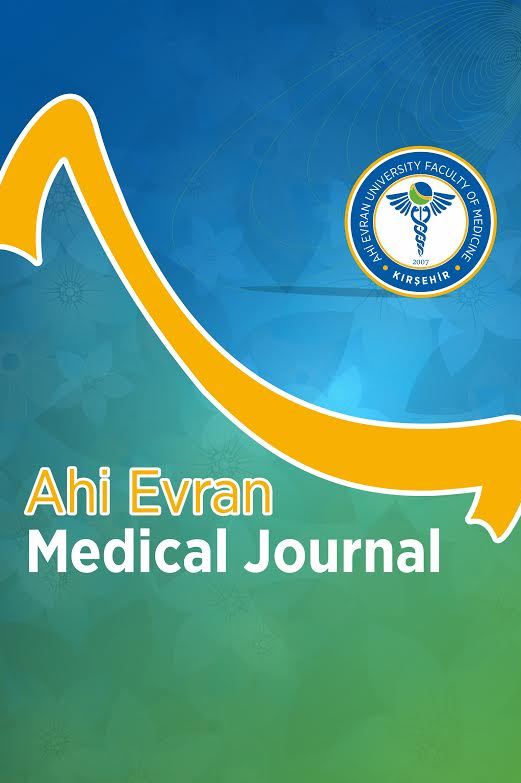Familyal Adenomatöz Polipozis Koli’li hastalarda Klinik ve Cerrahi Tedavi Sonuçlarımız
Familyal Adenomatöz Polipozis, kanser, kolektomi
Our Clinical and Surgical Treatment Results in Familial Adenomatous Polyposis Coli Patients
Familial Adenomatous Polyposis, Cancer, Colectomy,
___
- 1. Bhurwal A, Prochilo G, Patel AV. Familial adenomatous polyposis. Am J Med Sci. 2020;359(6):392-393.
- 2. Nielsen M, Hes FJ, Nagengast FM, et. al. Germline mutations in APC and MUTYH are responsible for the majority of families with attenuated familial adenomatous polyposis. Clin Genet. 2007;71(5):427-433.
- 3. Knudsen AL, Bülow S, Tomlinson I, Möslein G, Heinimann K, Christensen IJ. Attenuated familial denomatous polyposis: resultsfrom an internationa lcollaborative study. Colorectal Dis. 2010;12(10):243–249.
- 4. Half E, Bercovich D, Rozen P. Familial adenomatous polyposis. Orphanet J RareDis. 2009;4(1):22.
- 5. Aliosmanoğlu İ, Gül M, Hakseven M.ve ark. Familyal adenomatöz polipozis nedeniyle ameliyat ettiğimiz 24 hastanın analizi. Kolon Rektum Hast. Derg. 2013;23(1):38-43.
- 6. Arvanitis ML, Jagelman DG, Fazio VW, Lavery IC, McGannon E. Mortality in patients with familial adenomatous polyposis. Dis Colon Rectum. 1990;33(8):639-642.
- 7. Laurent S, Franchimont D, Coppens J. P. et. al. Familial adenomatous polyposis: clinical presentation, detection and surveillance. Acta gastroenterol. 2011;74(3):415-420.
- 8. Aihara H, Kumar N, Thompson CC. Diagnosis, surveillance, and reatment strategies for familial adenomatous polyposis: rationale and update. Eur J Gastroenterol Hepatol. 2014;26(3):255-262.
- 9. Campos FG. Surgical treatment of familial adenomatous polyposis: Dilemmas and currentre commendations. World J Gastroenterol. 2014;20(44):16620-16629.
- 10. Dolan S. Familial adenomatous polyposis: development, presentation, and treatment strategies. Clin J Oncol Nurs. 2019;23(2):135-138.
- 11. Abraham SC, Nobukawa B, Giardiello FM, Hamilton SR, WuTT. Sporadic fundic gland polyps: common gastric polyps arising through activating mutations in the beta-cateningene. Am J Pathol. 2001;158(3):1005-1010.
- 12. Groves CJ, Saunders BP, Spigelman AD, Phillips RK. Duodenal cancer in patients with familial adenomatous polyposis (FAP): results of a 10 year prospective study. Gut. 200;50(5):636-641.
- 13. Spigelman AD, Williams CB, Talbot IC, Domizio P, Phillips RK. Upper gastrointestinal cancer in patients with familial adenomatous polyposis. Lancet. 1989;2(8666):783-785.
- 14. Sherman J, Greenstein AJ, Greenstein AJ. Ileal j pouch complications and surgical solutions: a review. Inflamm Bowel Dis. 2014;20(9):1678-1685.
- 15. Aziz O, Athanasiou T, Fazio VW, et al. Meta-analysis of observational studies of ileorectal versus ilealpouch-anal anastomosis for familial adenomatous polyposis. Br J Surg. 2006;93(4):407-417.
- 16. Ng KS, Gonsalves SJ, Sagar PM. Ileal-anal pouches: A review of itshistory, indications, andcomplications. World J Gastroenterol. 2019;25(31):4320-4342.
- 17. Dalal RL, Shen B, Schwartz DA. Management of pouchitis and other common complications of the pouch. Inflamm Bowel Dis. 2018;24(5):989-996.
- 18. Fazio VW, Ziv Y, Church JM, et. al. Ileal pouch-anal anastomoses complications and function in 1005 patients. Ann Surg. 1995;222(2):120-127.
- 19. Sagar PM, Pemberton JH. Intraoperative, postoperative and reoperative problems with ileoanalpouches. Br J Surg. 2012;99(4):454-468.
- 20. MacLean AR, Cohen Z, MacRae HM, et. al. Risk of small bowel obstruction after the ileal pouch-anal anastomosis. Ann Surg. 2002;235(2):200-206.
- 21. Bach SP, Mortensen NJ. Ileal pouch surgery for ulcerativecolitis. World J. Gastroenterol. 2007;13(24):3288-3300.
- 22. Fazio VW, Kiran RP, Remzi FH, et. al. Ileal pouch anal anastomosis: analysis of outcome and quality of life in 3707 patients. Ann Surg. 2013;257(4):679-685.
- 23. Schiphorst AH, Verweij NM, Pronk A, Borel Rinkes IH, Hamaker ME. Non-surgical complications after laparoscopic and open surgery for colorectal cancer -A systematic review of randomised controlled trials. Eur J Surg Oncol. 2015;41(9):1118-1127.
- 24. Guzman-Pruneda, F. A., Husain, S. G., Jones, C. D. et.al. Compliance with preoperative care measures reduces surgical site infection after colorectal operation. J. Surg. Oncol. 2019;119(4):497-502.
- 25. Farouk R, Dozois RR, Pemberton JH, Larson D. Incidence and subsequent impact of pelvic abscess after ileal pouch-anal anastomosis for chronic ulcerative colitis. Dis Colon Rectum. 1998;41(10):1239-1243.
- 26. Pellino G, Frasson M, García-Granero A, et al. ANACO Study Group. Predictors of complications and mortality following left colectomy with primary stapled anastomosis for cancer: results of a multicentric study with 1111 patients. Colorectal Dis. 2018;20(11):986-995.
- 27. Heiskanen I, Luostarinen T, Järvinen HJ. Impact of screening examinations on survival in familial adenomatous polyposis. Scand J Gastroenterol. 2000;35(12):1284-1287.
- Yayın Aralığı: Yılda 3 Sayı
- Başlangıç: 2017
- Yayıncı: Kırşehir Ahi Evran Üniversitesi
Ali KIRIK, Hasan GÜREL, Sultan TÜREL, Hacer ŞEN
Solid Over Kitlelerinde Difüzyon Ağırlıklı Görüntüleme: Benign-Malign Ayrımında Faydalı Mı?
Fulya ÖZER, Cem ÖZER, Ozlem ALKAN, Haluk YAVUZ
Asemptomatik İçicilerde Sigara Bağımlılığının Noninvaziv Perfüzyon Parametrelerine Etkisi
Febril Konvülziyonlu Çocuklarda Risk Faktörlerinin Değerlendirilmesi
Serdar FİDAN, Erdal ÜNLÜ, Ramazan DULKADİR, Ali GÜNEŞ
Cinsiyet Farklılığının Sigara Bırakma Üzerindeki Etkisi
Neslihan ÖZÇELİK, Songül ÖZYURT
Duodenum Brunner Bezi Ezilme Artefaktının Görülme Sıklığı: Retrospektif Bir Çalışma
İlk Trimester Vitamin D, Vitamin B12 ve Ferritin Seviyelerinin Preeklampsi ile İlişkisi
Selim GÜLÜCÜ, Mehmet GÜÇLÜ, Sebahattin ÇELİK, İlkin Seda CAN, Canan SOYER ÇALIŞKAN, Samettin ÇELİK
